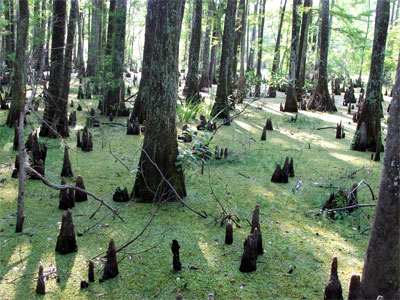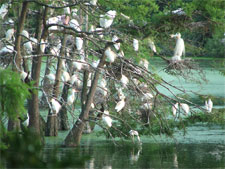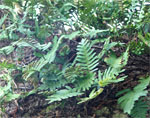Native Son – May, 2008

Shangri La Gardens’ magnificent swamp settings include bald cypress and pond cypress trees that survived Hurricane Rita.
Photos by Steven Chamblee.
The Road Trip to Shangri La

The rookery is populated by wetland birds like egrets, herons and spoonbills.
Nothing I like better than when the underdog toughs it out and snatches victory from the jaws of defeat: the first Rocky movie … “Dewey Defeats Truman!” … the ‘69 Miracle Mets … it just goes on and on. Garden-wise, the same feeling holds true: Fort Worth Botanic Garden Conservatory resurrected after the Hailstorm of ’95, Chandor Gardens revived after a 16-year abandonment, and Miami’s Kampong and Fairchild Botanic Garden coming back after being blown apart by Hurricane Andrew. There is just something inspiring about the character of the tenacious. And now, brothers and sisters, I have been to the mountaintop … Shangri La Gardens.
Hopped into the truck for the long haul down to Orange, Texas (20 miles northwest of Port Arthur, snuggled up against the Louisiana border), to attend the annual meeting of the Texas Association of Botanic Gardens. This is a loose-knit group of garden nuts, ahem, horticulture professionals, who have thrown aside aspirations of money and glory for the chance to live, sleep, and breathe plants 24/7/365. My kind of people….
At the conference, I hob-nobbed a bit with ever-intellectual author Scott Ogden, shared a few chortles with the perpetually grinning, omniscient Greg Grant, and tossed back some beer and gumbo with George Hull, the hippest professor/plant guru around. (Check out www.mswn.com for a peek at George’s genius.) But perhaps my favorite visit was a simple stroll around the greenhouse with Gary Outenreath, the immensely talented but always humble director of horticulture for Shangri La. Gary has survived many disasters and disappointments during his decades of service to various gardens, yet his eyes still sparkle and stories fall easily from his lips when he is surrounded by plants. My kind of people….
Shangri La Gardens hosted the event in grand style at their grand new facilities, sited at various locations around the property – a property that has a somewhat incongruous aura about it. This aura is quite palpable for hypersensitive types like me, and there’s good reason for it. Shangri La is a garden steeped in history – a history that has been wiped clean time and again.
Mr. H. J. Lutcher Stark created the garden and named it for the utopian place mentioned in James Hilton’s novel Lost Horizon. Born to wealth and privilege, Stark threw his passion and energy (and, of course, money) into developing a magnificent world of beauty and intrigue. For 20 years, the lush paradise bloomed away. But the dream came to an abrupt end in 1958, when a freak snowstorm blanketed the garden, killing the tropical collections and literally splintering thousands of ornamental trees and shrubs. After the storm, Stark lost interest in his quixotic fantasy, eventually choosing to simply lock the gates and let nature run her course.
More than 40 years later, the Stark Foundation sought to revive the garden, and made plans for her redevelopment. In 2005, just as plans were under way, Hurricane Rita rolled directly over Shangri La, leveling more than 30,000 trees and changing the pristine, nature-reclaimed landscape into a veritable war zone.
Rocked but undefeated, Shangri La rose again, this time with a conservation and education theme embedded into each component of the garden and buildings. It has earned the Platinum rating for LEED building standards (Google it), making it one of the “greenest” facilities in the entire nation. The formal gardens, strewn with long strolling paths, still await the fullness that only a few years of “growing out” can bring. The designs are crisp, the maintenance excellent, the amenities complete. But that’s only about half the story….
Electric boats take visitors down canals past literal “walls” of mature tupelo, bald cypress, and pond cypress trees (the only large species to survive the hurricane) into quiet coves, where the still waters are covered with solid mats of tiny aquatic plants through which arise a fantastic array of sculptural bald cypress “knees.” People naturally hush in this remarkable environment, instinctively surrendering to nature’s majesty. The scene is literally timeless, and one almost expects a dinosaur to appear in the distance. Half a mile away, hundreds of egrets, spoonbills, herons, and other birds jostle and vie for premiere positions in an immense rookery. A special blind lets visitors get great views without disturbing the birds’ natural habits.
I can’t think of another garden with such a dramatic juxtaposition of new and old, contrived and natural, technological and primordial. Almost oxymoronic is the constant reminder of the importance of water conservation in a garden surrounded by water. But Shangri La is in it for the long run, and the leaders know well their future, our future, lies in the decisions we make today that will make or break us tomorrow.
So I find myself wading through my thoughts as I make my way out of the garden —thinking of the inner drive that keeps this garden growing and brought this country through the Depression, the Dust Bowl, the World Wars, and many other events that put our society to the test. I pause underneath a live oak tree, one of the few trees to survive all the mayhem intact. I notice a sleeve of green growth upon the limbs, and break into a smile. Pleopeltis polypodoides, all right. A sweet little epiphytic fern that appears as delicate as a feather, but is, in fact, tough as nails and a true survivor. You see, it has the amazing knack of being able to go quickly dormant during dry spells, and can revive itself within mere hours of receiving moisture. Hmmm … just a coincidence to find this plant here at Shangri La? Nah. This is just the right place for a plant most folks around here call “resurrection fern.”

Resurrection fern, Pleopeltis polypodoides.
About the author: Steven Chamblee is the chief horticulturist for Chandor Gardens in Weatherford and a regular contributor to Neil Sperry’s GARDENS magazine and e-gardens newsletter.
Learn more about Shangri La Botanical Gardens and Nature Center by visiting www.shangrilagardens.org/.

